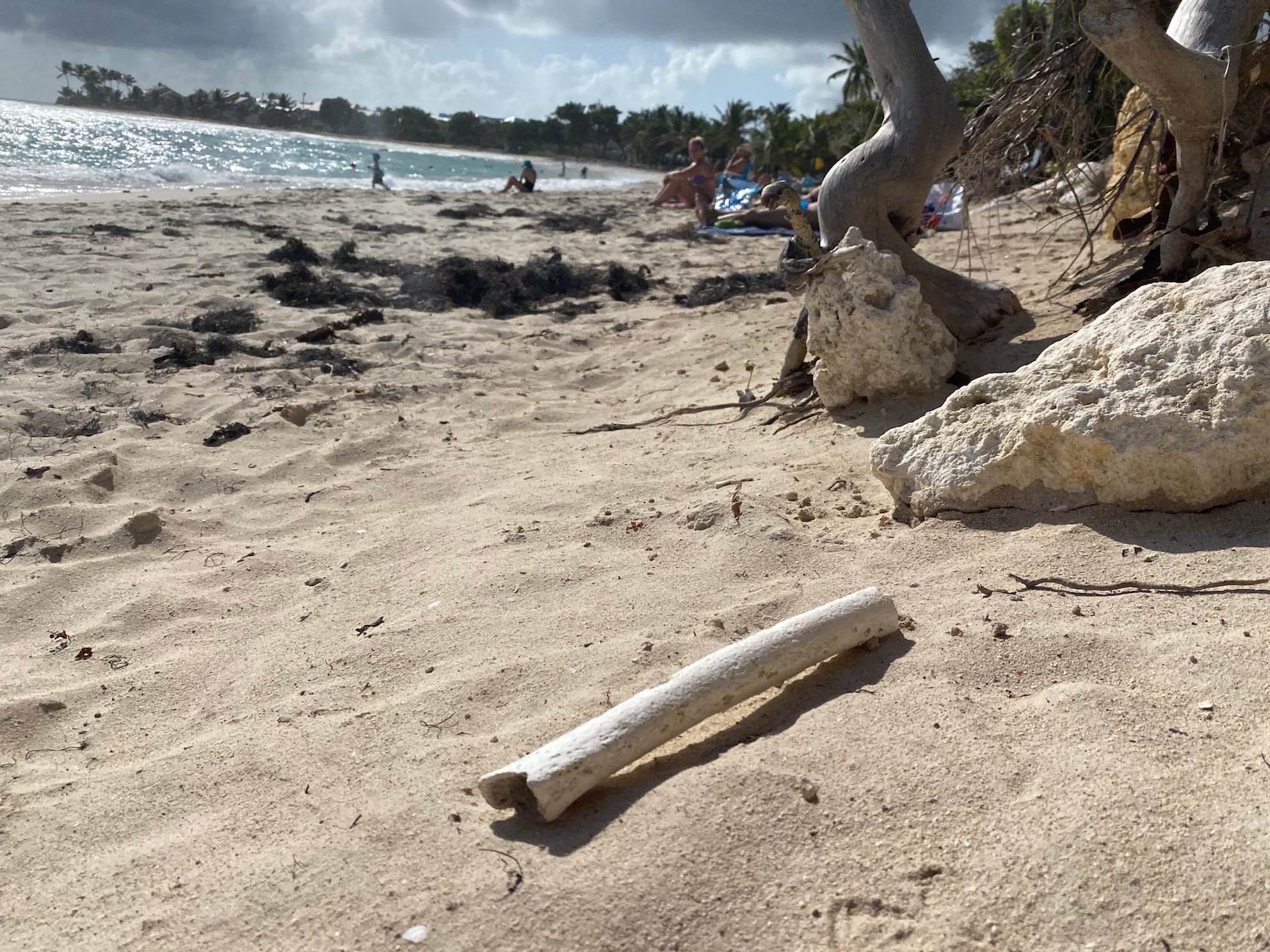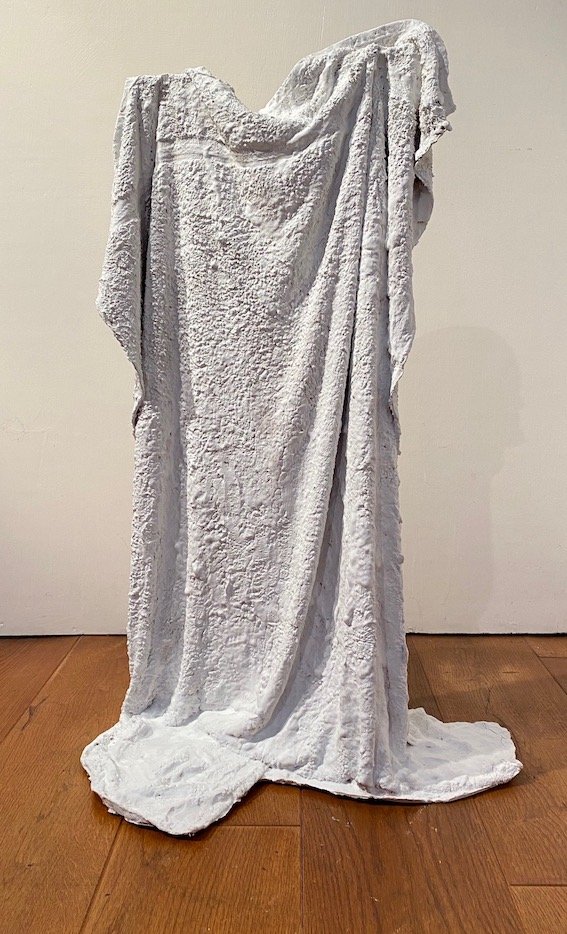A BEACH IN THE CARIBBEAN
For the last 2 years I have been exploring a particular beach, on the French Caribbean island of Guadeloupe where my mother was born.
Beach in Guadeloupe - French West Indies
This beach is popular with locals and tourists alike.
Since the 1960’s it is been subjected to increasingly strong maritime erosion caused by rising sea levels and regular hurricanes which have exposed the remains of hundred of bodies buried during the 18th and 19th centuries in a slave cemetery which now lay only just a few inches below the sand. Regularily one can find bones spread all over the beach.
The works shown here have evolved from a close, ongoing observation of this particular beach in Guadeloupe and my personal re-connection to my Caribbean roots.
Since starting to make work based on A Beach in the Caribbean I have come to realise that I grieve with my hands.
This is a still from the video "The Beach" 3’04” (see below) with Abas Ahmed and myself turning the pages of Book of Towels
Contains audio
Book of Towels shown as part of the installation La Chambre des Parents @ depARTures N4, London. July 2022
Contains audio
A BEACH IN THE CARIBBEAN - 2 - Book of Towels (2022)
Book of monotypes on glassine paper, Book of Towels is an attempt to record a trace of the presence of the hundreds of bodies, soon disappearing, who have been buried on a beach in Guadeloupe and whose remains are being washed away by the sea.
Each print of a towel stands for a person buried on this beach. I consider the book as a list of names for the nameless.
The prints are relief prints made on glassine paper, which I choose for the sound it produces when turning the pages. It evokes pebbles, waves swelling and breaking on the shore.
The weight, seize and fragility of the paper command the pace at which the pages can be turned, mirroring the fact that it is not possible to accelerate the movement of waves, gently inviting the page turner to reflect on each imprint.
Medium : Ink, glassine paper Seize (open) : 195cm X 75cm
A Boat of Shells and Bones (2022) Medium : Wire, tissue paper, PVA, Injet prints on board. Size: 280cm X 75cm X 60cm
A BEACH IN THE CARIBBEAN - 3 : A Boat of Shells and Bones (2022)
Conch shells once upon a time iconic symbol of the Caribbean islands, have been overfished and are, by now, an endangered species. In Guadeloupe, at carnival they lead the crowds, but conch shells are also traditionally used to mark out and decorate graves. A Boat of Shells and Bones - is a tribute to the shared history of Europeans, Africans and native Caribs who have lived on Raisins Clairs beach, perished at sea to reach the shore or whose remains, once buried on the beach are now washed away in the ocean. The work looks like a hybrid of the carcass of a sea creature and a 3 seater kayak, sprouting offshoots of conch shells, seemingly bearing signs of new growth. Raisins Clairs 3 - A Boat of Shells and Bones - is made of a wire structure, wrapped in tissue paper brushed with PVA glue. Photographic prints of conch shells mounted on black card are attached to the structure with wires. The Boat is suspended by fishing threads, in an ascending diagonal line across the room. The kayak is a recurrent element in my visual vocabulary. I see it as a symbol of agency and the opposite of the slave ship. The 3 seater kayak is also a reference and tribute to my parents and brother who have recently passed away and whose remains are resting on 3 different continents. The ashes of my mother are in Guadeloupe, whilst my father and brother are buried respectively in Paris and Lomé (Togo) in West Africa.
A Boat of Shells and Bones, as part of the installation La Chambre des Parents @ depARTures N4, London. July 2022
On the wall and above the mantelpiece are what I consider the 2 totemic figures of my parents, made of adhesive tape, one black, the other transparent, wrapped around an assemblage of half a kayak paddle and half a crutch. The cast created was subsequently cut open to release the paddle and the crutch, leaving 2 polymorph figures possibly resembling the discarded empty exoskeletons of insects.
The 2 figures are the protagonists of the video work “Quizas” which shows them engaging in a sensuous and playful courtship ritual at sunset on a beach.
To navigate and to stand could sum up the symbolic parental legacy of the paddle and the crutch; their fusion embodies simultaneously trans generational trauma, resilience and self-determination.
This is my island in the sun (2022) Medium: Plaster, towel Seize: 90cm X 50 cm X 50 cm
Using, what I consider, the most mundane object to delineate personal space on a beach; the beach towel, I dipped my own towel in plaster and let it dry. It now stands alone, suspended like a ghostly shroud, as I wonder where is my place on this island? Where do I lay my towel? Where could I find rest? Where do I position myself in the complexity of the beach, the bones, the tourists? In a wider sense, how do we position ourselves in relation to death, history, dissociation and respect for our ancestors? How do we live alongside loss?
A BEACH IN THE CARIBBEAN - 4 - Maman Figuier (2022) Medium: Extension hair, copper pipes Size:180 cm x 150 cm x 170 cm
Please click here for Maman Figuier 1 minute close up video
Maman Figuier presents itself as two lush, undulating freestanding braids of black hair joined on the upper part of the sculpture as "the head" so to speak. The hair reaches all the way to the ground, seemingly feeling its way forward, expanding in several directions. This work was inspired by the powerful tropical fig trees which can be found throughout the Guadeloupean landscape. Some fig trees have managed to dismantle many landmark buildings inherited from the colonial era (such as sugar mills). In the fishing town of Petit Canal, a colossal fig tree literally broke down a pillar of the old colonial regime; the walls of a slave prison. In this instance, it seems that the tree successfully managed what humans couldn't achieve. Fig Tree Woman is a tribute to the powerful Caribbean female figures of resistance against the colonial system (ie the heroic mulatress Solitude in Guadeloupe), who drew their strength from an acute knowledge of nature (from their kitchen gardens to the islands’ landscape at large).
Maman Figuier @ Some Of Us Are Brave - Exhibition curated by Sukai Eccleson for Casildart in Oxford in partnership with FusionArts Oxford- March 2022
A BEACH IN THE CARIBBEAN - 5 - Red Bear Island (2022) Pencil drawing.
A BEACH IN THE CARIBBEAN - 6 - Les Parents (2022) 120cm X 29cm X 18cm. Packaging tapes.
A BEACH IN THE CARIBBEAN - 7 - QUIZAS Video 2’44”
A BEACH IN THE CARIBBEAN - 8 - Toujours Recommencée - 2 - Detail of installation in the garden @ depARTures N5 July 2022
A BEACH IN THE CARIBBEAN - 8 - Toujours Recommencée - 1 - Photograph - (2022)












